How to eliminate clogging in the sink: an overview of 4 best ways to solve a problem
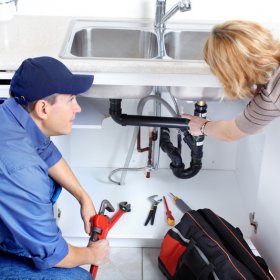
All people periodically encounter such an unpleasant household phenomenon as a blockage in the pipes. This happens from time to time due to banal sloppiness when using plumbing fixtures. Clogging can occur in the sink in the kitchen if there is no special grate for garbage, or in the sink in the bathroom, where hair, pieces of soap and other small items get.
They form dense deposits, which impede the flow of water. And, since this problem is a lot of inconvenience, it needs to be addressed quickly. You can call the plumber, but you can’t always find it right away, and calling it and the services are not cheap, so it’s best to study it yourself how to eliminate blockage in the sink.
Content
A selection of the best ways
There are several ways to clean the sink, and to solve the clogging problem, you can try everything in turn, until one of them gives a satisfactory result.
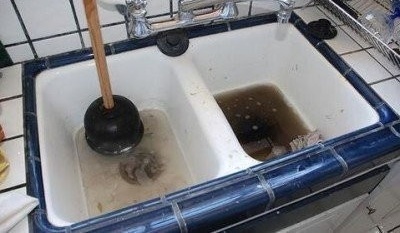
A clogged sink is the result of sloppiness when using plumbing. Food waste, body fat or hair, soap bars and other particles eventually clog the sink and the water stops leaving it
Method # 1 - good old plunger
Most often, a siphon is clogged in the sink, which connects it to the sewer. It is designed so that the drained water does not immediately fall from the sink into the sewer pipe, but is partially delayed in it by bending. The generated water shutter keeps odors from spreading in the kitchen or bathroom. The easiest and most affordable way to remove clogging in the sink is to use an old plunger familiar to everyone, which is found in almost every house. It helps, as a rule, in most cases, therefore it is a very popular method of restoring the outflow of water during blockages.
The classic plunger consists of a rubber hood with a wooden handle. When pressed, the plugs formed in the sink are destroyed by mechanical pressure. To clean the sink with the help of a plunger, it is preliminarily poured halfway with hot water and vigorously pressed into the discharge place, creating pressure drops. As a result, the blockage is destroyed, and the water can leave unhindered.
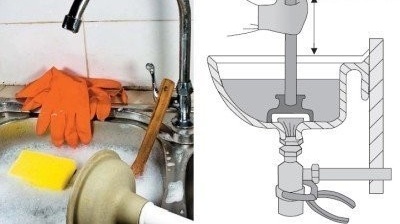
A plunger is the simplest plumbing tool that should be in every home. This is the easiest and most common way to eliminate clogging in the sink.
You may also find the instructions for cleaning up blockages in the sewer pipe useful:https://aquatech.tomathouse.com/en/uchebnik/truby/prochistka-kanalizacionnyx-trub.html.
If the reason for the clogging of the sink is caused by small particles of food waste and garbage, and if the clogging is small, the plunger will do the job.And if the particles are large and the clogging is quite old, the plunger may not be suitable for solving the problem. Then you have to resort to other cleaning options.
Method # 2 - chemicals
Unlike the previous version, there is no need to exert physical force. Instead, you will do everything special chemical compounds designed to eliminate blockages in sinks and sewers. They contain various alkalis and acids that dissolve inorganic and organic compounds. The stores currently offer various means to eliminate blockages, you just need to choose the right one. For metal and metal-plastic pipes, you should choose the tool "Mole", and "Tiret", "Mr. Muscle", "Domestos" are suitable for any pipes.
The purchased product should be poured into a drain pipe (wearing protective rubber gloves) and wait about five hours, and it is best to pour boiling water overnight and in the morning. This type of cleaning may not give a result after the first attempt. Therefore, actions with a chemical agent must be repeated, which, of course, is a minus of this method of combating blockage. In any case, you should not refuse it, it is quite simple and cheap.
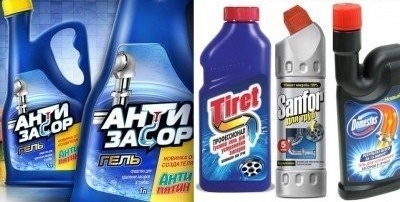
To eliminate the blockages that have appeared, as well as to prevent their occurrence, special chemical agents are used that dissolve the mud deposits in the pipes
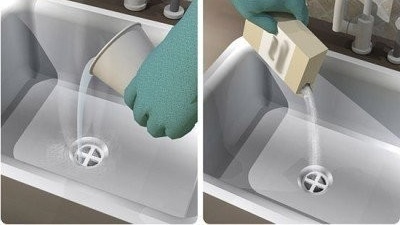
Baking soda and vinegar essence are excellent folk remedies for eliminating blockages in the sink. Gases and bubbles generated as a result of a chemical reaction will help remove contaminants deposited on the pipes.
If the house did not have at the right time special chemicals, you can use baking soda and vinegar essence. A packet of soda is poured into the drain, a bottle of 70% of the essence is poured and after some time washed with hot water.
Method # 3 - disassemble and clean the siphon
When the plunger has been tried and dry cleaned, but the blockage still remains, you have to think about how to remove it, what other method to choose for this. There is a more radical option that will definitely help. This is the disassembly and cleaning of the siphon. It is in it that most often the garbage accumulates through the grate, which closes the drain hole. This is facilitated by the curved shape of the pipe.
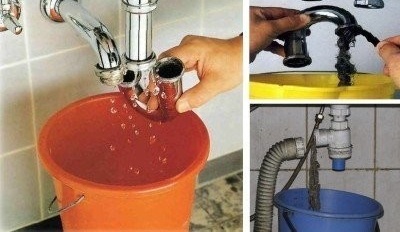
The surest way to eliminate clogging in the sink is to dismantle and clean the siphon, where mud deposits accumulate that impede the release of water
The procedure is as follows:
- we dismantle the siphon, this is done easily, especially if the siphon is plastic, do not forget to put a bucket under it;
- we unscrew the lower and upper retaining rings, disconnect the siphon from the pipe;
- remove all trash from the inside, rinse with hot water, degreasing agents;
- if the siphon is corrugated, then remove it, wrap one end of the corrugation with polyethylene, pour hot water and then tightly wrap the other end of the hose with foil. We straighten it and perform circular motions. Water cleans all folds of the corrugation, washing off fat deposits;
- carefully assemble the structure back, check how the situation has changed.
If the cause of the blockage was to fill the siphon with garbage, then after cleaning it, the water will leave instantly from the sink.
This procedure is much more difficult to perform with a cast-iron siphon, since it will take a long time to unscrew the rusted bolts, remove the cover and then clean the pipe with a cable. Therefore, to easily solve the problem of clogging, it is better to install a modern plastic sewage system.
Method # 4 - we clean the pipes with a plumbing cable
There are times when the siphon is already washed, and the water still slowly leaves. This means that the dirt is stuck somewhere far in the sewer pipe. In this case, you will need a plumbing flexible cable. Let's figure out how to break through the resulting garbage jam with a cable to eliminate blockage in the sink.
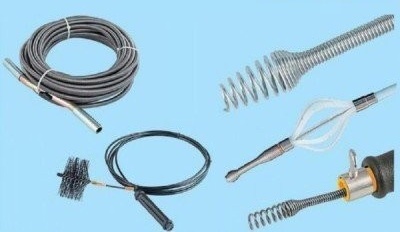
A flexible plumbing cable with or without different nozzles will help to break through the debris plug formed in the depth of the sewer pipe, which will eliminate the blockage in the sink
Read recommendations for cleaning the bath and sink drains from blockages here:https://aquatech.tomathouse.com/en/voprosy/20734.html.
A plumbing cable is a three-meter-long wire wrapped in a spiral, one end of which looks like a spiral drill, and the other end ends with a handle. The thickness of the cable is different and is selected taking into account the width of the pipe. Here's how to do it:
- The end of the cable is pushed into the bypass pipe and is directed towards the intended site of clogging.
- At the same time, with the help of the handle, the cable is constantly twisted around the longitudinal axis.
- After pushing the cable to the blockage, you should make it several movements "back and forth", which will help to destroy the mud plug. We move the cable carefully so as not to damage the surface of the pipe, especially if the communications are old and have not changed for a long time.
- We remove the cable and wash it from pollution.
After making sure that the blockage was cleaned, we rinse the pipes with a large amount of hot alkaline solution.
How to prevent blockages?
Each of the above methods to eliminate blockages is good in its own way. But do not ignore the home methods of preventing blockages, because by paying due attention to them, you can minimize the appearance of blockages in the sewer system:
- In many cases, the cause of clogging of the sinks is the formation of a garbage plug in the pipe. To avoid this, you need to try not to drain the leftover food and fat from the dishes into the sink, but rather into the toilet.
- In order to get as little trash as possible into the drain, it is necessary to install special metal nets. At least once a week, it is advisable to wash the sink drain (but not plastic) with boiling water, and pour special means to remove blockages into the drain hole twice a month.
- When replacing a sewer system, it is better to give preference to plastic drains and pipes. Elements from this material are more durable and not subject to corrosion.
Annoying blockages can also occur in the toilet. Our material contains methods and instructions that will help you solve this problem yourself:https://aquatech.tomathouse.com/en/santehnika/unitaz-rakovina/chto-delat-esli-zasorilsya-unitaz.html.
As you can see, preventive measures to prevent blockages are quite simple, but their observance will help you not to face an unpleasant cleaning situation.
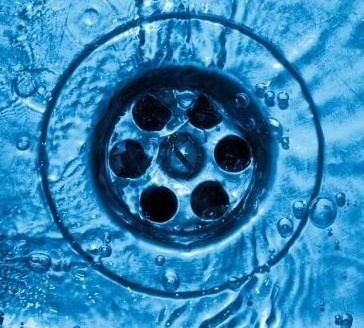
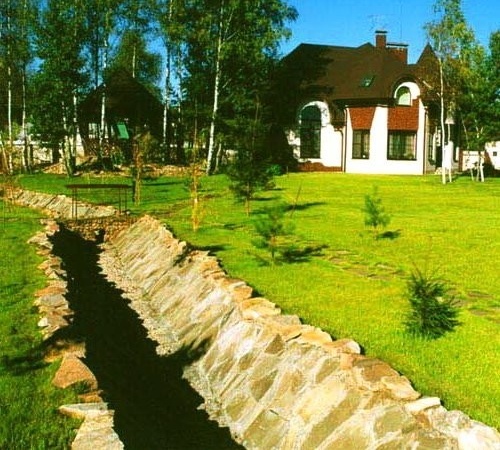

4 comments